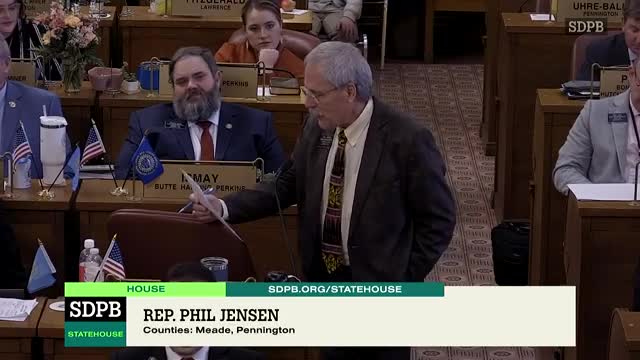South Dakota House votes down controversial House Bill 1105 regarding school mandates
February 12, 2025 | 2025 Legislative SD, South Dakota
This article was created by AI summarizing key points discussed. AI makes mistakes, so for full details and context, please refer to the video of the full meeting. Please report any errors so we can fix them. Report an error »

In a spirited session of the South Dakota House of Representatives, the debate surrounding House Bill 1105 took center stage, igniting passionate discussions about local control in education. As representatives gathered under the bright lights of the chamber, the atmosphere was charged with differing opinions on the role of state mandates in schools.
The bill, which proposed requiring schools to display the state seal prominently, faced significant opposition. Representative de Groot, taking the floor, expressed his concerns about the increasing number of mandates imposed on local school boards. He questioned the necessity of such requirements, suggesting that schools should have the autonomy to make decisions without state interference. “Maybe we should just rename this body the state school board instead of the state legislature of South Dakota,” he remarked, emphasizing his belief that local governance should prevail.
In contrast, Representative Jordan voiced support for the bill, arguing that displaying the state seal is a straightforward and harmless addition to school environments. He encouraged his colleagues to vote in favor, framing the proposal as a simple enhancement to school decorum.
However, Representative Heerman countered this perspective, reminding the assembly that school board members are elected by their communities to make these decisions. He argued that schools already have the ability to display the state seal if they choose, making the legislation unnecessary. “This is not needed legislation,” he concluded, urging a vote against the bill.
As the debate unfolded, it became clear that the issue at hand was not just about a seal on the wall, but rather a broader discussion about the balance of power between state and local governance in education. The representatives weighed their votes carefully, reflecting on the implications of their decisions.
Ultimately, the House voted on House Bill 1105, resulting in a defeat with 30 votes in favor and 38 against. The outcome underscored the ongoing tension between state mandates and local control, leaving many to ponder what future legislative sessions might hold for South Dakota's educational landscape.
The bill, which proposed requiring schools to display the state seal prominently, faced significant opposition. Representative de Groot, taking the floor, expressed his concerns about the increasing number of mandates imposed on local school boards. He questioned the necessity of such requirements, suggesting that schools should have the autonomy to make decisions without state interference. “Maybe we should just rename this body the state school board instead of the state legislature of South Dakota,” he remarked, emphasizing his belief that local governance should prevail.
In contrast, Representative Jordan voiced support for the bill, arguing that displaying the state seal is a straightforward and harmless addition to school environments. He encouraged his colleagues to vote in favor, framing the proposal as a simple enhancement to school decorum.
However, Representative Heerman countered this perspective, reminding the assembly that school board members are elected by their communities to make these decisions. He argued that schools already have the ability to display the state seal if they choose, making the legislation unnecessary. “This is not needed legislation,” he concluded, urging a vote against the bill.
As the debate unfolded, it became clear that the issue at hand was not just about a seal on the wall, but rather a broader discussion about the balance of power between state and local governance in education. The representatives weighed their votes carefully, reflecting on the implications of their decisions.
Ultimately, the House voted on House Bill 1105, resulting in a defeat with 30 votes in favor and 38 against. The outcome underscored the ongoing tension between state mandates and local control, leaving many to ponder what future legislative sessions might hold for South Dakota's educational landscape.
View full meeting
This article is based on a recent meeting—watch the full video and explore the complete transcript for deeper insights into the discussion.
View full meeting